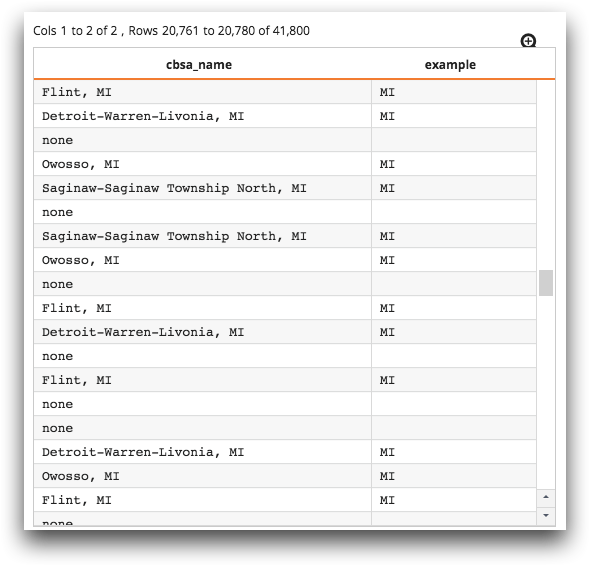dropto(X;Y)
Returns the remaining part of a given string after the characters up to and including the first occurrence of a particular substring are dropped.
Syntax
dropto(X;Y)Input
| Argument | Type | Description |
|---|---|---|
X |
text | The string on which to apply the function A column name |
Y |
text | A substring in X that defines the point after which the
resultant string begins |
Return Value
Returns the text string in X that follows the first occurrence of the
string Y. In other words, the characters up to and including the first
occurrence of Y are dropped, and the remaining string is returned.
If X is N/A, the result is N/A. If there is no occurrence of
Y in X, the result is N/A.
Sample Usage
value |
instance |
dropto(value;instance) |
|---|---|---|
| 'ana@aol.com' | '@' | 'aol.com' |
Example
In the "ZIP to CBSA Mapping" table (pub.geo.cbsa), the values in the
cbsa_name column consist of strings of the form
"city, state". You can drop the
text up to and including the ", " to obtain just the name of the
state. To do this, create a computed column and
apply the dropto(X;Y) function to the cbsa_name column,
specifying the string ", " as the Y parameter.
<base table="pub.geo.cbsa"/> <willbe name="example" value="dropto(cbsa_name;', ')"/> <colord cols="cbsa_name,example"/>

For those values that do not have this "city,
state" structure, an N/A is returned.
Additional Information
- This function does not work with Unicode (UTF-8) strings.
- For Unicode-compliant alternatives, consider:
strdrop(X;Y;N)strtrim(X;Y;C;D)strfind(X;Y;I)strextract(X;P;N)
